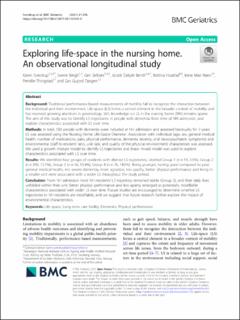| dc.description.abstract | Background
Traditional performance-based measurements of mobility fail to recognize the interaction between the individual and their environment. Life-space (LS) forms a central element in the broader context of mobility and has received growing attention in gerontology. Still, knowledge on LS in the nursing home (NH) remains sparse. The aim of this study was to identify LS trajectories in people with dementia from time of NH admission, and explore characteristics associated with LS over time.
Methods
In total, 583 people with dementia were included at NH admission and assessed biannually for 3 years. LS was assessed using the Nursing Home Life-Space Diameter. Association with individual (age, sex, general medical health, number of medications, pain, physical performance, dementia severity, and neuropsychiatric symptoms) and environmental (staff-to-resident ratio, unit size, and quality of the physical environment) characterises was assessed. We used a growth mixture model to identify LS trajectories and linear mixed model was used to explore characteristics associated with LS over time.
Results
We identified four groups of residents with distinct LS trajectories, labelled Group 1 (n = 19, 3.5%), Group 2 (n = 390, 72.1%), Group 3 (n = 56, 10.4%), Group 4 (n = 76, 14.0%). Being younger, having good compared to poor general medical health, less severe dementia, more agitation, less apathy, better physical performance and living in a smaller unit were associated with a wider LS throughout the study period.
Conclusion
From NH admission most NH residents’ LS trajectory remained stable (Group 2), and their daily lives unfolded within their unit. Better physical performance and less apathy emerged as potentially modifiable characteristics associated with wider LS over time. Future studies are encouraged to determine whether LS trajectories in NH residents are modifiable, and we suggest that future research further explore the impact of environmental characteristics. | en_US |

